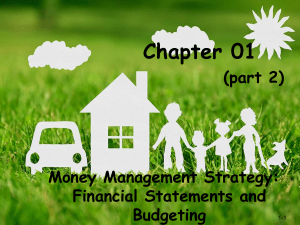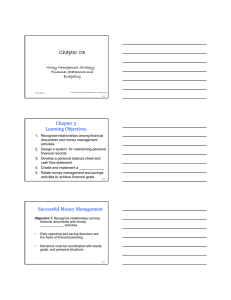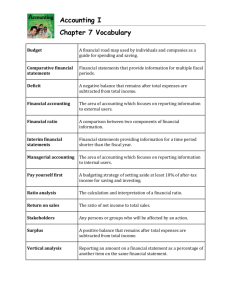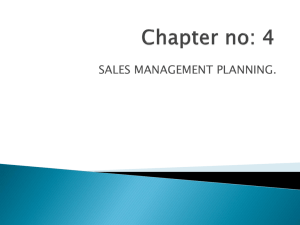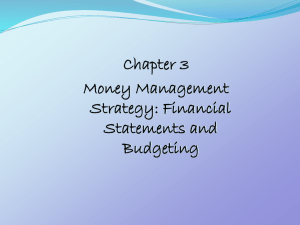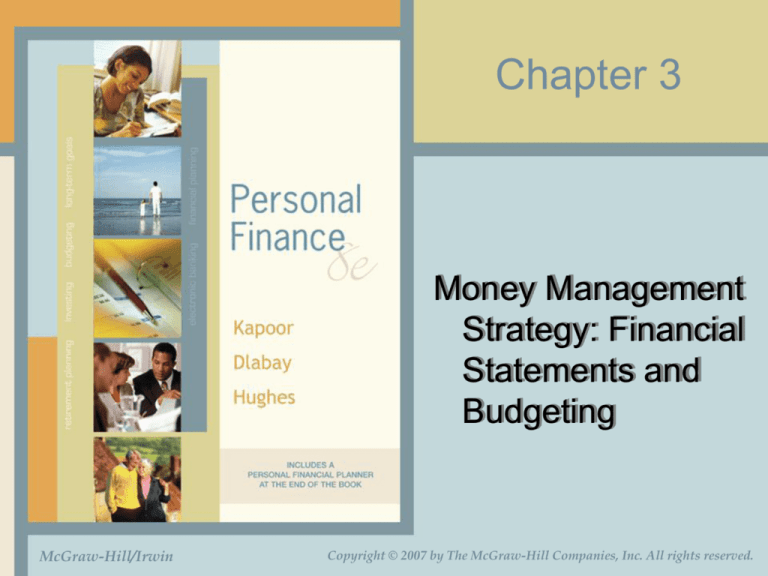
Chapter 3
Money Management
Strategy: Financial
Statements and
Budgeting
McGraw-Hill/Irwin
Copyright © 2007 by The McGraw-Hill Companies, Inc. All rights reserved.
Planning for Successful
Money Management
• Daily spending and saving decisions are
the heart of financial planning.
• Decisions must be coordinated with
needs, goals, and personal situations.
• Money management is the day-to-day
financial activities needed to manage
personal economic resources, while
working toward long-term financial
security.
3-2
Opportunity Cost and
Money Management
• Spending money on current living
•
•
•
•
expenses reduces the amount you can
save and invest.
Saving and investing for the future reduces
the amount you can spend now.
Buying on credit ties up future income.
Using savings for purchases results in lost
interest and depletes savings.
Comparison shopping can save money but
takes valuable time.
3-3
Major Money Management Activities
Storing
and
maintaining
personal
financial
records
and
documents.
Creating
personal
financial
statements
(balance
sheets and
cash flow
statements
of income
and
outflow).
Creating and
implementing
a plan for
spending,
and saving
(budgeting).
3-4
Benefits of an Organized System of
Financial Records
• Handling daily business affairs,
•
•
•
•
including payment of bills on time.
Planning and measuring financial
progress.
Completing required tax reports.
Making effective investment decisions.
Determining available resources for
current and future buying.
3-5
What to Keep in Your Home File
• Items you refer to often.
Personal and employment records.
Money management records.
Tax records.
Financial services records.
Consumer purchase, auto and credit records.
Housing records.
Insurance records.
Investment records.
Estate planning and retirement records.
3-6
What to Keep in a Safe Deposit Box
• Safe deposit box is for records that would
be hard to replace.
Birth, marriage and death certificates, copy of will
Citizenship and military papers.
Adoption and custody papers.
Serial numbers and photos of valuables.
CDs and credit and banking account numbers.
Mortgage papers and titles.
List of insurance policy numbers.
Stock and bond certificates.
Coins and other collectibles.
3-7
Records on Personal Computer
• Home computer.
Current and past budgets.
Summary of checks written and other
banking transactions.
Past income tax returns prepared with tax
preparation software.
Account summaries and performance
results of investments.
Computerized versions of wills,
estate plans, and other documents.
3-8
How Long to Keep Records
• Birth certificates, wills, and Social
Security information should be kept
indefinitely.
• Keep records on personal property and
investments as long as you own them.
• Keep documents related to the purchase
and sale of real estate indefinitely.
• Copies of tax returns and supporting
data should be kept six years.
3-9
Purpose of Personal
Financial Statements
• Report your current financial position in
relation to the value of the items you own
and the amounts you owe.
• Measure your progress toward your
financial goals.
• Maintain information on your financial
activities.
• Provide data you can use when preparing
tax forms or applying for credit.
3-10
Components of a Balance Sheet
(net worth statement)
• Assets - what you own.
Liquid assets.
Real estate.
Personal possessions.
Investment assets.
• Liabilities - what you owe
Current liabilities (< 1 year).
Long term liabilities.
• Compute your net worth.
Assets minus liabilities.
3-11
Where Did Your Money Go? Components
of a Cash Flow Statement
• Shows inflow, outflow for a given time
period.
Record inflow.
• Net income from employment.
• Savings and investment income.
• Other sources.
Record cash outflows.
• Fixed and variable expenses.
• Net cash flow can be a surplus or a deficit.
• Use this statement as a basis for creating
a spending, saving and investment plan.
3-12
Ratios for Evaluating Financial
Progress
• Debt ratio = total liabilities/net worth; compares
debt to net worth; lower debt ratio is best
• Current ratio – liquid assets/current liabilities;
shows how well short term assets cover short
term debt; higher ratio is good
• Liquidity ratio = liquid assets/monthly expenses;
shows # of months that living expenses can be
paid; higher ratio is good
• Debt payments ratio = monthly credit
payments/take-home pay; try to keep ratio below
20%
• Savings ratio = monthly savings/gross income;
Americans tend to be poor savers; shoot for at
least 10%
3-13
Purposes of a Budget
• In contrast to cash flow, which was a
record of how you spent money in a past
time period, a budget is a plan for
spending in the future, such as for the
next month. A budget helps you…
Live within your income.
Spend your money wisely.
Reach your financial goals.
Prepare for financial emergencies.
Develop wise financial management habits.
3-14
Creating and Implementing a Budget
• Assessing your current situation.
Measure your current financial position.
Determine your needs, values and life
situation.
• Steps in the budgeting process.
Set financial goals.
2 Estimate income from all sources.
3 Budget amount for an emergency fund,
periodic expenses and financial goals.
4 Budget set amounts that you are obligated to
pay. These are your fixed expenses. BE
1
SURE TO BUDGET FOR SAVINGS.
3-15
Creating and Implementing a Budget
• Steps in the budgeting process
(continued).
5
6
Estimate amounts that are to be spent for
household and living expenses. These are
your variable expenses.
Record actual amounts for inflows and
outflows, comparing actual amounts with
budgeted amounts to determine variances.
7
Deficits and surpluses.
Review your spending and savings
patterns and evaluate whether
revisions are needed in your
savings and spending plans.
3-16
Characteristics of Successful Budgeting
• Well planned.
• Realistic.
• Flexible.
• Clearly communicated.
3-17
Selecting a Budgeting System
1)
2)
3)
4)
Mental budget – it is all in your head
Physical budget-use envelopes for
your expenses such as food, rent.
Written budget – use spreadsheets
Computerized budget – use
software such as Quicken
(www.quicken.com)
3-18
Saving to Achieve Financial Goals
• Common reasoning for saving include…
To set aside money for irregular and
unexpected expenses.
To pay for the replacement of expensive items,
such as cars or a down payment on a house.
To buy special items like recreational
equipment or to pay for a vacation.
To provide for long-term expenses such as
retirement or the education of children.
To earn income from the interest on savings for
use in paying living expenses.
3-19
Savings Techniques-If I don’t see it, I
won’t spend it
• Payroll deductions into saving accounts
• Automatic payments from checking into
savings accounts or mutual funds
• Saving regularly in 401(k) plans
• Also save coins, make periodic deposits
• Write a check each payday as a % of
income and deposit into savings
3-20
Money Management & Achieving
Financial Goals
• Balance Sheet reports current financial
position
• Cash Flow Statement shows cash you
have received and spent in the past
• Budget helps you to spend and save to
achieve financial goals
3-21
Assignments
• Prepare a balance sheet for yourself
• Prepare a cash flow statement for last
month
• Prepare a monthly budget
• Monitor the budget and show variances
3-22
Online Research
• Do an online search to see if you can find
the savings rate in the United States.
• How does your savings ratio compare to
the average?
3-23

